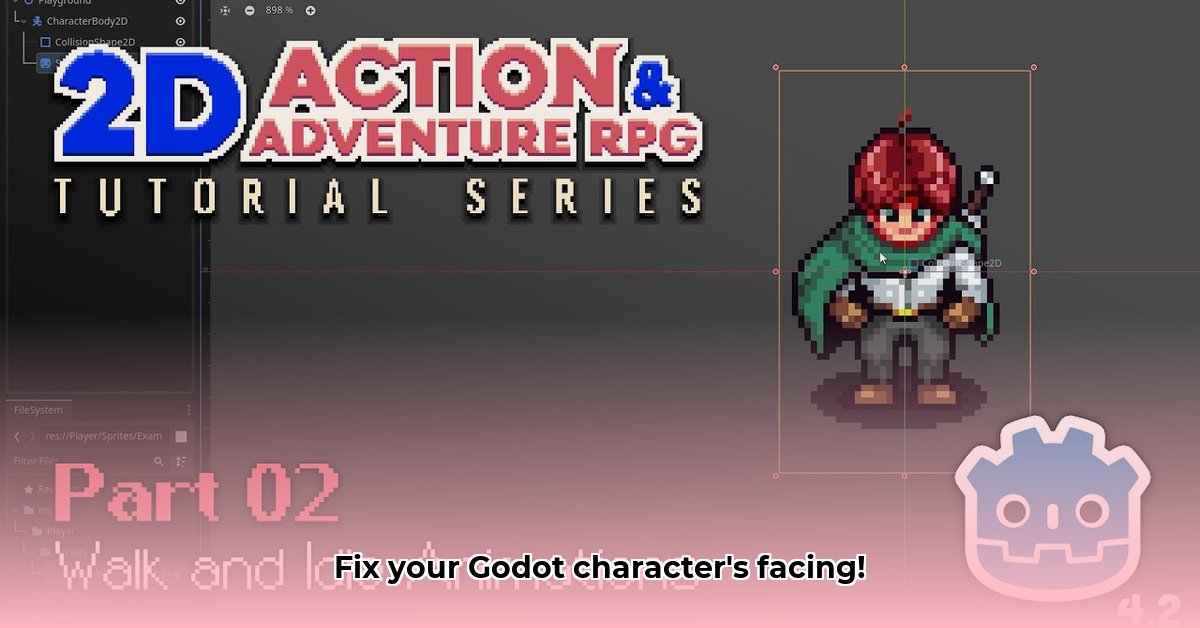# Godot Character Facing Fix: A Comprehensive Guide
Is your Godot character moonwalking backward or facing the wrong way entirely? Fear not! This guide offers comprehensive solutions for character facing issues, from basic sprite flipping to advanced animation techniques. Whether you're a beginner or an experienced Godot developer, you'll find the answer here to get your character looking in the right direction.
## Part 1: Understanding and Fixing Basic Sprite Flipping
Let's start with the fundamental issue: getting your character to face left or right correctly. This often involves simply flipping the sprite.
### Why is My Character Facing the Wrong Way?
The core problem usually lies in how your character's movement code interacts with its visual representation (the sprite). You need to ensure that when the character moves left, the sprite faces left, and vice versa. This involves telling Godot to "flip" the sprite horizontally.
### Step-by-Step Guide to Basic Sprite Flipping
Here's how to get your character facing the right way:
**Step 1: Accessing the Sprite Node**
First, you need to access the `Sprite2D` node in your scene. This is the node that displays your character's image. You can do this using `get_node()` or the `$` shorthand notation. For example, if your sprite node is named "Sprite", you can access it in your script like this:
```gdscript
var sprite = $Sprite
Step 2: Flipping the Sprite
Godot provides the flip_h property to flip a sprite horizontally. Setting flip_h to true will flip the sprite, and setting it to false will unflip it.
Step 3: Integrating Flipping with Movement
Now, you need to integrate the flipping logic with your character’s movement code. This usually happens in the _physics_process() function, which is called every physics frame. Here’s an example:
extends CharacterBody2D
var speed = 200
func _physics_process(delta):
var direction = Input.get_vector("move_left", "move_right", "move_up", "move_down")
velocity = direction * speed
move_and_slide()
if direction.x > 0:
$Sprite.flip_h = false # Face right
elif direction.x < 0:
$Sprite.flip_h = true # Face left
In this code:
- We get the input direction using
Input.get_vector(). - We set the character’s velocity based on the direction.
- We flip the sprite based on the horizontal component of the direction (
direction.x).
Step 4: Handling Idle State
You might want to ensure your character faces a default direction when idle (not moving). You can add an else condition to the flipping logic:
if direction.x > 0:
$Sprite.flip_h = false # Face right
elif direction.x < 0:
$Sprite.flip_h = true # Face left
else:
# Optionally, set a default facing direction when idle
$Sprite.flip_h = false # Face right by default
Troubleshooting Common Issues
- “Invalid set index ‘flip_h’ (on base: ‘Node2D’) with value of type ‘bool’.” This error means you’re trying to set
flip_hon a node that doesn’t have that property. Double-check that you’re targeting the correctSprite2Dnode. - Character only faces right. Ensure your
elifcondition is correctly checking fordirection.x < 0. Also, make sure you’re not accidentally overriding theflip_hproperty elsewhere in your code. - Character jitters when changing direction. This can happen if your input values are noisy (e.g., due to gamepad stick drift). Consider adding a deadzone to your input:
var direction = Input.get_vector("move_left", "move_right", "move_up", "move_down", 0.2) # 0.2 is the deadzone
Part 2: Advanced Character Facing with AnimationPlayer
Things get more complex when you use the AnimationPlayer to control your character’s animations. The AnimationPlayer can override your manual sprite flipping, leading to unexpected results.
The AnimationPlayer Problem
The AnimationPlayer stores animation tracks that define the properties of nodes over time. If an animation track modifies the flip_h property, it will override any changes you make in your code.
Solution 1: Prioritize Script Control
This is generally the preferred approach. Ensure your script always has the final say on the flip_h property after the AnimationPlayer has finished its work for the current frame.
Step 1: Disabling flip_h in Animations (If Necessary)
If your animations are explicitly setting flip_h, remove those tracks from your animations. You want your script to be solely responsible for flipping the sprite.
Step 2: Flipping After Animation Playback
In your _physics_process() function, make sure the flipping logic happens after you call animation_player.play() or any other animation-related function.
extends CharacterBody2D
@onready var animation_player = $AnimationPlayer
@onready var sprite = $Sprite
var speed = 200
func _physics_process(delta):
var direction = Input.get_vector("move_left", "move_right", "move_up", "move_down")
velocity = direction * speed
move_and_slide()
# Play animations based on movement (example)
if velocity.length() > 0:
animation_player.play("walk")
else:
animation_player.play("idle")
# Flip the sprite *after* the animation
if direction.x > 0:
sprite.flip_h = false # Face right
elif direction.x < 0:
sprite.flip_h = true # Face left
Solution 2: Using Signals for Synchronization
A more robust approach is to use signals to synchronize your script with the AnimationPlayer.
Step 1: Connect to the animation_finished Signal
Connect to the animation_finished signal of the AnimationPlayer. This signal is emitted whenever an animation finishes playing.
@onready var animation_player = $AnimationPlayer
@onready var sprite = $Sprite
func _ready():
animation_player.animation_finished.connect(_on_animation_finished)
func _on_animation_finished(anim_name):
# This function is called when an animation finishes
# You can put your flipping logic here
var direction = Input.get_vector("move_left", "move_right", "move_up", "move_down")
if direction.x > 0:
sprite.flip_h = false # Face right
elif direction.x < 0:
sprite.flip_h = true # Face left
Step 2: Implement the Signal Handler
In the _on_animation_finished() function, add your flipping logic. This ensures that the sprite is flipped after the animation has completed, preventing conflicts.
Solution 3: Adjusting Parent Node Scale
As alternative, instead of manipulating the flip_h property of the Sprite node directly, you can adjust the scale of its parent node. This technique provides a way to flip the character’s orientation without directly modifying the sprite’s properties.
Step 1: Access the Parent Node
First, you need to access the parent node of your Sprite node. You can do this using the get_parent() method or the $ shorthand notation
Step 2: Scale the Parent Node
Instead of flipping the sprite directly, you adjust the scale of the parent node. A scale of (-1, 1) will flip the image horizontally, while (1, 1) will revert it to the original orientation.
extends CharacterBody2D
export var speed = 200
@onready var sprite = $Sprite
func _physics_process(delta):
var velocity = Vector2.ZERO
if Input.is_action_pressed("ui_right"):
velocity.x += 1
if Input.is_action_pressed("ui_left"):
velocity.x -= 1
velocity = velocity.normalized() * speed
velocity = move_and_slide(velocity)
if velocity.x > 0:
sprite.get_parent().scale.x = 1
elif velocity.x < 0:
sprite.get_parent().scale.x = -1
By adjusting the parent node’s scale, you effectively flip the entire character, including any child nodes attached to it. This approach can be simpler for certain setups, but it’s essential to consider how it might affect other aspects of your character’s behavior.
- Explore Stardew Valley Nexus Mods to Transform Your PC Farming Game - December 7, 2025
- Stardew Valley Mods Steam Setup for Your Perfect Farm Life - December 6, 2025
- Sims 4 Mods to Make Your Game Much More Fun - December 5, 2025










